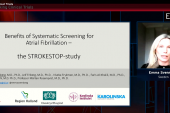USPSTF: Data Around Screening for AF in Asymptomatic Adults Still Lacking
The group reiterated its previous “I” statement, meaning there’s not enough evidence to assess the balance of benefits and harms.

Evidence regarding screening for atrial fibrillation (AF) in asymptomatic adults without a history of TIA/stroke remains insufficient to definitively weigh the potential benefits and harms, according to updated guidance from the US Preventive Services Task Force (USPSTF).
The task force maintained its “I” statement when it comes to AF screening, a stance similar to its previous guidance issued in 2018, which specifically assessed the use of ECG to look for subclinical episodes of the arrhythmia in adults 65 and older. The 2022 iteration takes into account studies assessing a wider range of screening modalities—including consumer wearable devices, automated blood pressure cuffs, and pulse oximeters—and lowers the age of the population to which the guidance applies (to 50 years).
Still, as the task force members see it, there are no definitive data to support recommending for or against this type of screening compared with usual care.
The evidence base “really, in the aggregate, is insufficient to inform whether we should do anything more in terms of screening for atrial fibrillation,” Carol Mangione, MD (University of California, Los Angeles), vice chair of the USPSTF, told TCTMD. “The important caveat about that is we’re comparing these screening tests to usual primary care, and the task force considers checking the pulse as usual primary care. So when you think about any of these tests, you have to think about the ability to detect atrial fibrillation by doing pulse palpation versus one of these other approaches.”
Mangione stressed that an “I” statement is not a recommendation against screening for AF, highlighting the need for tailored decision-making. “In these situations, it’s very important that primary care doctors and their patients discuss the potential need for screening for atrial fibrillation based on other conditions the patient might have that put them at higher risk and to make a judgment for that individual beyond the pulse pressure,” she said.
The USPSTF notes that guidance from the American Heart Association/American Stroke Association states that, for people older than 65, screening for AF in primary care settings using pulse assessment—followed by ECG, if necessary—can be useful. Mangione said that’s similar to the stance of the task force, as pulse palpation is considered part of usual care.
Evaluating New Evidence
The USPSTF based its new guidance on an updated evidence review performed by Leila Kahwati, MD (RTI International – University of North Carolina at Chapel Hill Evidence-based Practice Center), and colleagues, which included 26 studies with a total of 113,784 participants. Nearly half of those analyses, Kahwati told TCTMD via email, were not assessed for the 2018 document.
The conclusion of the review is that “although screening can detect more cases of unknown AF, evidence regarding effects on health outcomes is limited,” Kahwati et al write. “Anticoagulation was associated with lower risk of first stroke and mortality but with increased risk of major bleeding, although estimates for this harm are imprecise; no trials assessed benefits and harms of anticoagulation among screen-detected populations.”
One randomized trial published since 2018, STROKESTOP, did provide a positive result, showing that twice-daily ECG screening for 2 weeks lowered composite events (ischemic stroke, hemorrhagic stroke, systemic embolism, all-cause mortality, and hospitalization for bleeding) over a median follow-up of 6.9 years (HR 0.96; P = 0.045).
The trial, however, was not seen as definitive because of several limitations. Those include, according to Kahwati, a lack of formal masking of the intervention; the lack of central, blinded endpoint adjudication; use of an endpoint that combines safety and efficacy outcomes; the fact that half of individuals invited to participate declined; and the inclusion of some individuals (about 12%) who had known AF at baseline, many of whom were already on anticoagulation. “So it’s not clear whether these study findings are applicable to screening in asymptomatic populations without known AF,” she said.
Asked why it’s been difficult to establish a link between increased detection of AF through screening and improvements in clinical outcomes, Kahwati pointed out that the benefits of anticoagulation have been established in populations of patients with persistent and/or permanent AF that was detected clinically. “We do not know whether the benefit of anticoagulation is the same in persons with paroxysmal AF or in persons whose AF is detected through screening (ie, testing in asymptomatic persons),” she said. “So although the evidence is clear that more AF can be detected with screening, it might not be the kind of AF that causes strokes.”
She noted that in the LOOP trial, which involved looking for AF with an implantable loop recorder, initiating anticoagulation for AF episodes lasting at least 6 minutes did not improve clinical outcomes. “Some of the people identified using this threshold might not have been at high risk for stroke to begin with,” Kahwati noted, “because the duration of time they spent in AF was so low (particularly if you compare it to persons with persistent AF).”
Commenting for TCTMD, Steven Lubitz, MD (Massachusetts General Hospital, Boston), highlighted this issue as well. As the field moves away from studies looking at screening at a single time point toward those evaluating continuous monitoring, shorter episodes of AF will be detected, and those are probably associated with a lower stroke risk, he said, adding that this concept has been borne out in studies like STROKESTOP and LOOP. “I think that these studies are challenging to do because we don’t really know where the greatest burden of stroke risk lies with atrial fibrillation episodes,” Lubitz said.
Excitement About the Field
The types of studies needed to determine the impact of screening for AF in asymptomatic populations more conclusively, according to Mangione, are large RCTs directly comparing screening with usual care in asymptomatic populations that are powered to assess both the effects on clinical outcomes and the potential harms. It’s very important, she added, for these trials to enroll sufficient numbers of both men and women as well as individuals from diverse racial/ethnic groups.
The guidance document also calls for additional studies to learn how to optimize the accuracy of screening tests or strategies, to understand the risk of stroke conferred by subclinical AF or episodes detected with consumer devices (and how that risk differs based on AF duration or burden), and to assess the impact of anticoagulation in patients with subclinical AF.
Lubitz said some of the research required to move the field forward are already underway, noting that the overall landscape is changing. Existing guidance mostly addresses clinician-guided screening for AF, he said. “However, with the increasing access to wearable devices that can detect atrial fibrillation, I think that a lot of this is out of the clinicians’ hands, and the paradigm’s shifting away from whether the clinician should direct or prescribe screening to how should the clinician respond to detections that are occurring among users of these types technologies out there,” Lubitz said.
“There still remains a large question about whether clinicians should be prescribing certain forms of screening for atrial fibrillation that haven’t been very well studied yet, and that largely includes wearable devices,” he continued. “It is possible that at some point clinicians will be prescribing wearable devices or ECG patch monitors or other forms of screening to their highest-risk patients, but whether or not those trials will be powered properly and conducted to measure hard endpoints is yet to be determined.”
Nevertheless, Lubitz said progress is being made. “I think in the next few years we probably will figure out in which scenarios specifically we should be screening and how we should be screening for atrial fibrillation, and I think we’re also going to understand how to incorporate the data safely and responsibly into routine medical practice,” he said. “And I think we’re going to—very importantly—start to come up with guidance for how clinicians should handle” this information and how individuals “should handle detections from their consumer wearable devices that are increasingly picking up irregular heart rhythms. I’m excited about all of this.”
In an accompanying editorial, Philip Greenland, MD (Northwestern University Feinberg School of Medicine, Chicago, IL), senior editor of JAMA, also has an eye on the future.
“As the USPSTF and a recent report from a National Heart, Lung, and Blood Institute workshop noted, many questions about screening for atrial fibrillation remain unanswered,” he says. “But there is great enthusiasm for AF screening and optimism for the future role of wearables that could revolutionize this field, provide more precise targeting of anticoagulant drugs, and simultaneously reduce overall risks of stroke in atrial fibrillation. The hope is that a future USPSTF report will eventually be able to either endorse—or advise clearly against—AF screening by ECG based on clear, objective evidence from well-conducted randomized trials.”
Todd Neale is the Associate News Editor for TCTMD and a Senior Medical Journalist. He got his start in journalism at …
Read Full BioSources
US Preventive Services Task Force. Screening for atrial fibrillation: US Preventive Services Task Force recommendation statement. JAMA. 2022;327:360-367.
Kahwati LC, Asher GN, Kadro ZO, et al. Screening for atrial fibrillation: updated evidence report and systematic review for the US Preventive Services Task Force. JAMA. 2022;327:368-383.
Greenland P. Screening for atrial fibrillation – more data still needed. JAMA. 2022;327:329-330.
Disclosures
- The evidence review was funded under a contract from the Agency for Healthcare Research and Quality, US Department of Health and Human Services, to support the USPSTF.
- Kahwati and Mangione report no relevant conflicts of interest.
- Greenland reports research grants from the National Institutes of Health and the American Heart Association.





Comments